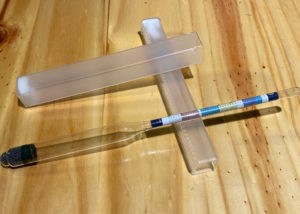Step 5:
BOTTLING / STORING
BOTTLing AND STORAGE
Storing homemade mead properly is important to maintain its quality and taste over the long term.
Storing homemade mead properly is important to maintain its quality and taste over time. There are several steps you can take to ensure your mead stays fresh and delicious, including crash cooling and stabilizing.
Crash cooling is the process of rapidly cooling your mead after fermentation to help clarify it and remove any remaining yeast or sediment. To do this, you will need to move your mead to a refrigerator or other cool environment for a few days. This will cause any remaining yeast or sediment to settle to the bottom of the container. Once the mead has cleared, you can use a siphon to transfer the mead into a new container for further aging or bottling.
Stabilizing your mead involves adding chemicals to prevent further fermentation and help maintain its flavor and color over time. The two most common stabilizing agents used in mead making are potassium sorbate and campden tablets. Potassium sorbate is added to prevent any remaining yeast from reproducing, while campden tablets release sulfur dioxide to inhibit the growth of bacteria and other organisms.
To stabilize your mead, you will need to add the appropriate amount of stabilizing agent to your mead and mix well. The amount needed will depend on the volume of mead you are stabilizing and the specific product you are using, so be sure to follow the manufacturer’s instructions carefully. Once the stabilizing agent has been added, you can bottle your mead for long-term storage in a variety of bottles such as swing top or wine bottles.
When storing your mead, it’s important to keep it in a cool, dark place to avoid exposure to sunlight and high temperatures, which can negatively impact its quality. Ideally, you should store your mead at a temperature between 50-70°F (10-21°C). Additionally, storing your mead horizontally, when applicable, can help prevent the cork or cap from drying out, which can lead to spoilage.
It’s also a good idea to periodically check on your mead to ensure it is still in good condition. Over time, sediment may settle at the bottom of the bottle, which is normal and can be gently agitated and removed if necessary. If you notice any off flavors or aromas, it may be a sign that your mead has gone bad and should be discarded.
By following these steps, you can store your homemade mead properly and enjoy its delicious flavors for months or even years to come.
– Content on this site was created by or with the help of the ChatGPT and the OpenAI project.
This site is a participant in the Amazon Services LLC Associates Program and As an Amazon Associate may earn from qualifying purchases.







